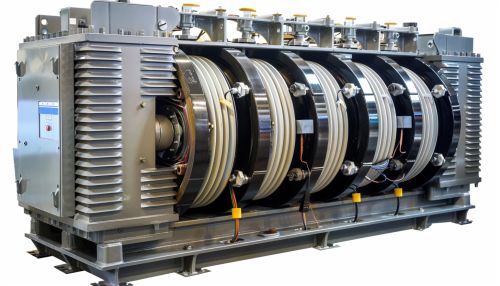Transformer
Introduction
A transformer is a static electrical device that transfers electrical energy between two or more circuits through electromagnetic induction. A varying current in any one coil of the transformer produces a varying magnetic flux in the transformer's core, which induces a varying electromotive force across any other coils wound around the same core. Electrical energy can be transferred between the (possibly many) coils, without a metallic connection between the two circuits.
Principle of Operation
Transformers operate on the principle of electromagnetic induction, as discovered by Michael Faraday. Faraday's law of induction states that the electromotive force (EMF) induced in a circuit is proportional to the rate of change of the magnetic flux through the circuit. This principle allows transformers to step up or step down the voltage of alternating current (AC) electrical signals, enabling the efficient transmission and distribution of electrical power.


Types of Transformers
There are several types of transformers, each designed for specific applications and operating conditions. These include power transformers, distribution transformers, instrument transformers, and pulse transformers, among others.
Power Transformers
Power transformers are used in transmission networks for step-up and step-down applications (400 kV, 200 kV, 110 kV, 66 kV, 33kV) and are generally rated above 200MVA. They are primarily used in power generation stations and transmission substations.
Distribution Transformers
Distribution transformers are used for lower voltage distribution networks as a means to end user connectivity. They are typically rated less than 200 MVA and are used in the distribution of electricity at lower voltages.
Instrument Transformers
Instrument transformers include current transformers and potential transformers. They are designed to provide a scaled-down replica of the current or voltage in a power line for metering and protective relay applications.
Pulse Transformers
Pulse transformers are used in the generation and distribution of high-power pulses. They are commonly used in radar equipment and other pulsed power applications.
Construction
The construction of a transformer includes several components: the core, the windings, the insulation, the tank, and the bushings. Each of these components plays a crucial role in the operation, safety, and efficiency of the transformer.
Core
The core of a transformer is typically made of a high permeability silicon steel or amorphous steel, which provides a path for the magnetic flux. The core is laminated to minimize eddy current losses.
Windings
The windings are typically made of copper or aluminum. The high-voltage (HV) windings are wound with a larger diameter wire than the low-voltage (LV) windings to withstand the higher voltage.
Insulation
The insulation in a transformer serves to electrically isolate the primary and secondary windings from each other and from the transformer's core. It also helps to prevent the breakdown of the winding material.
Tank
The tank of a transformer serves as the outermost layer of the transformer and is typically filled with insulating oil which cools and insulates the transformer.
Bushings
Bushings are insulating devices that allow an electrical conductor to pass safely through a grounded conducting barrier such as the case of a transformer or circuit breaker.
Applications
Transformers are essential for the transmission, distribution, and utilization of alternating current electrical energy. They are used to increase (step up) or decrease (step down) voltages. Transformers are also used in electronic products to step down the voltage of the power supply to the levels suitable for the low voltage circuits they contain.
